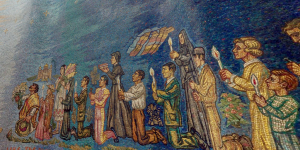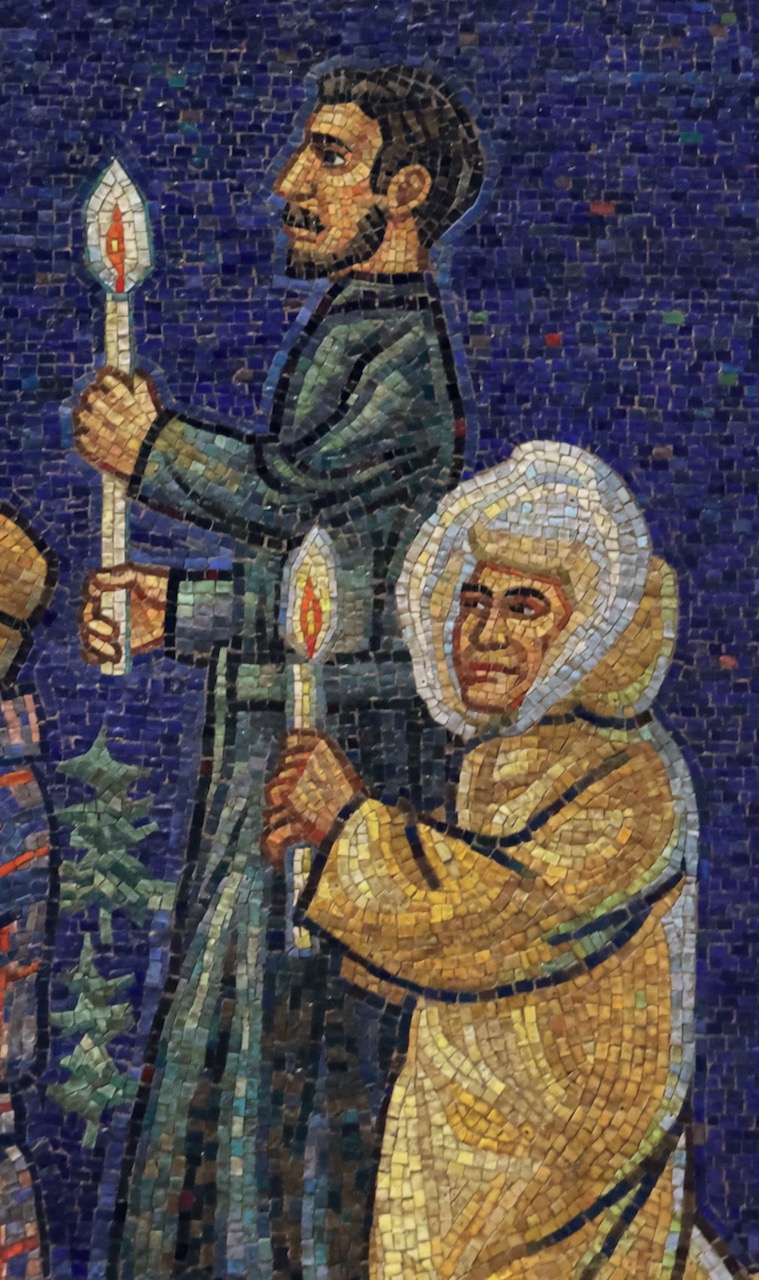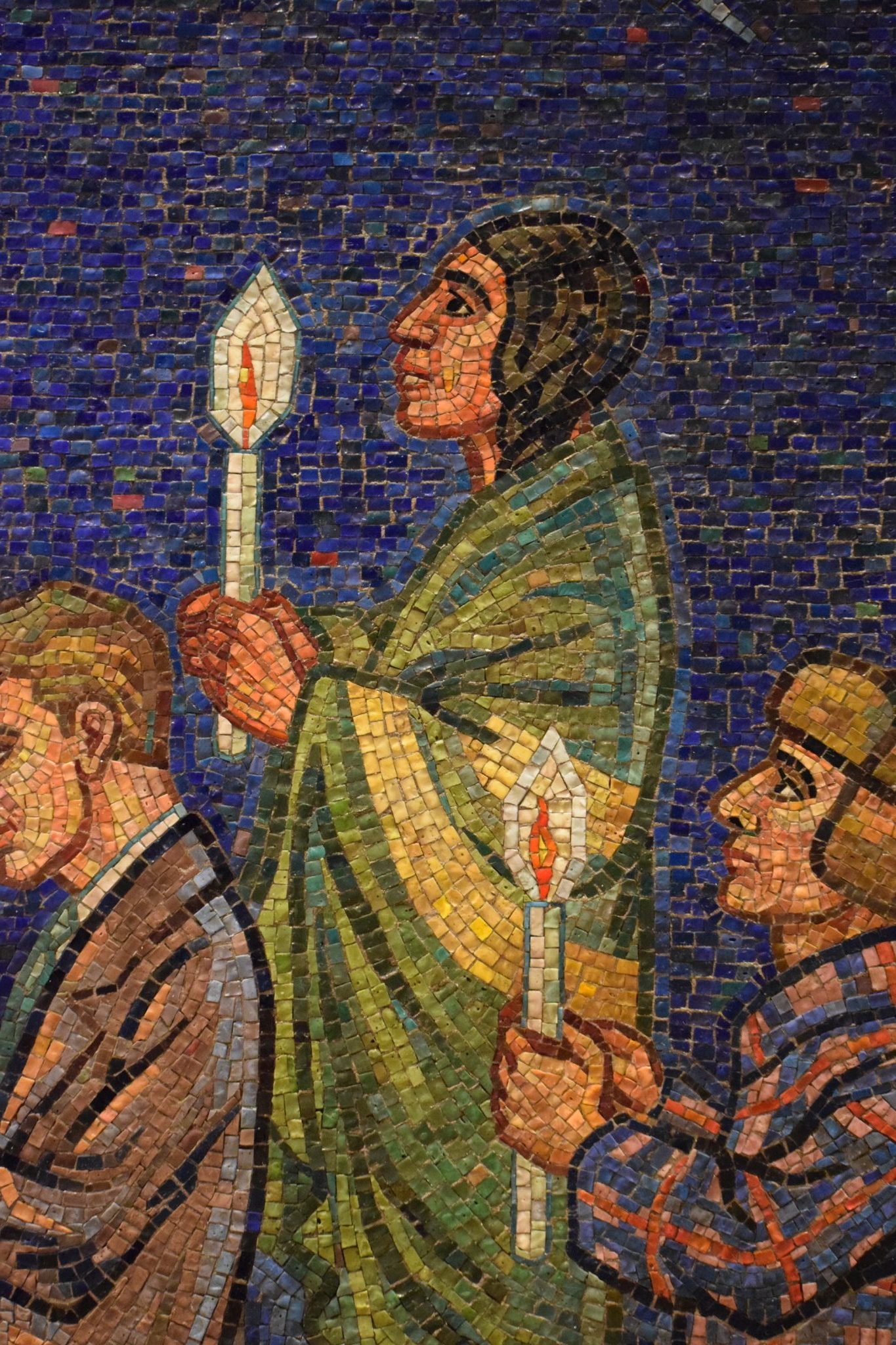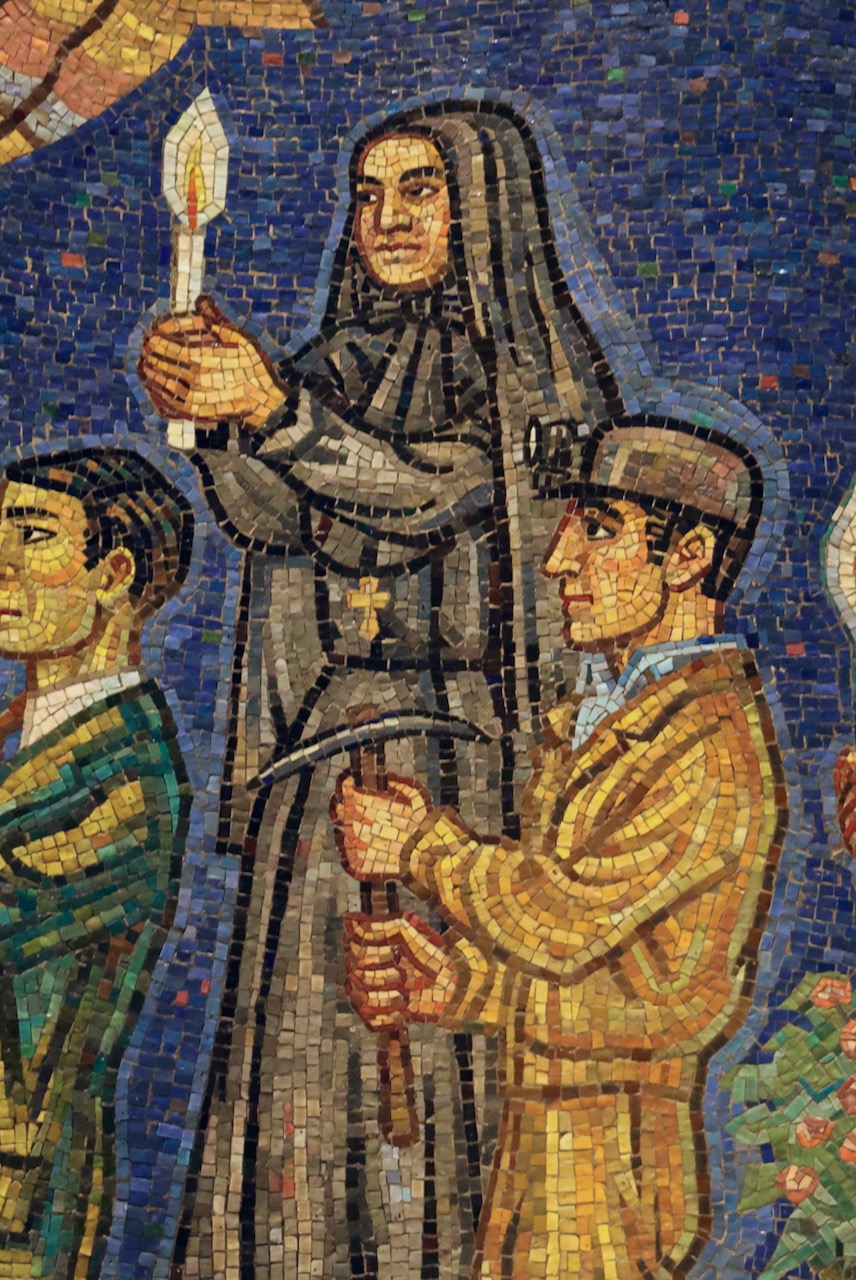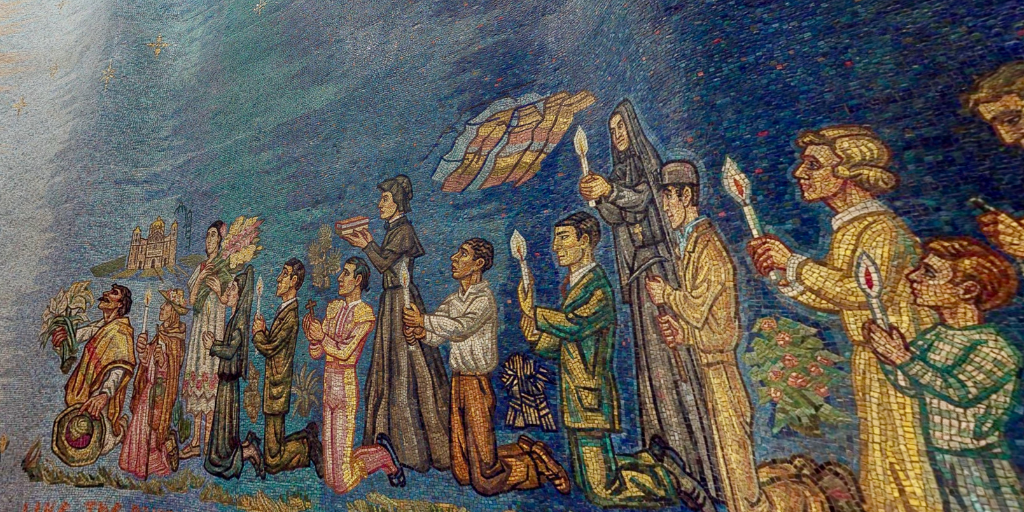
At the Basilica, the Our Lady of Guadalupe Chapel not only honors the major Marian apparition of the New World – it also portrays various significant Catholics from the history of the Americas. As we celebrate the Feast of Our Lady of Guadalupe this week, we invite you to learn about the saints and historic figures portrayed in the Our Lady of Guadalupe Chapel.
This post is part II in a series – view part I.
St. Juan Diego Cuauhtlatoatzin
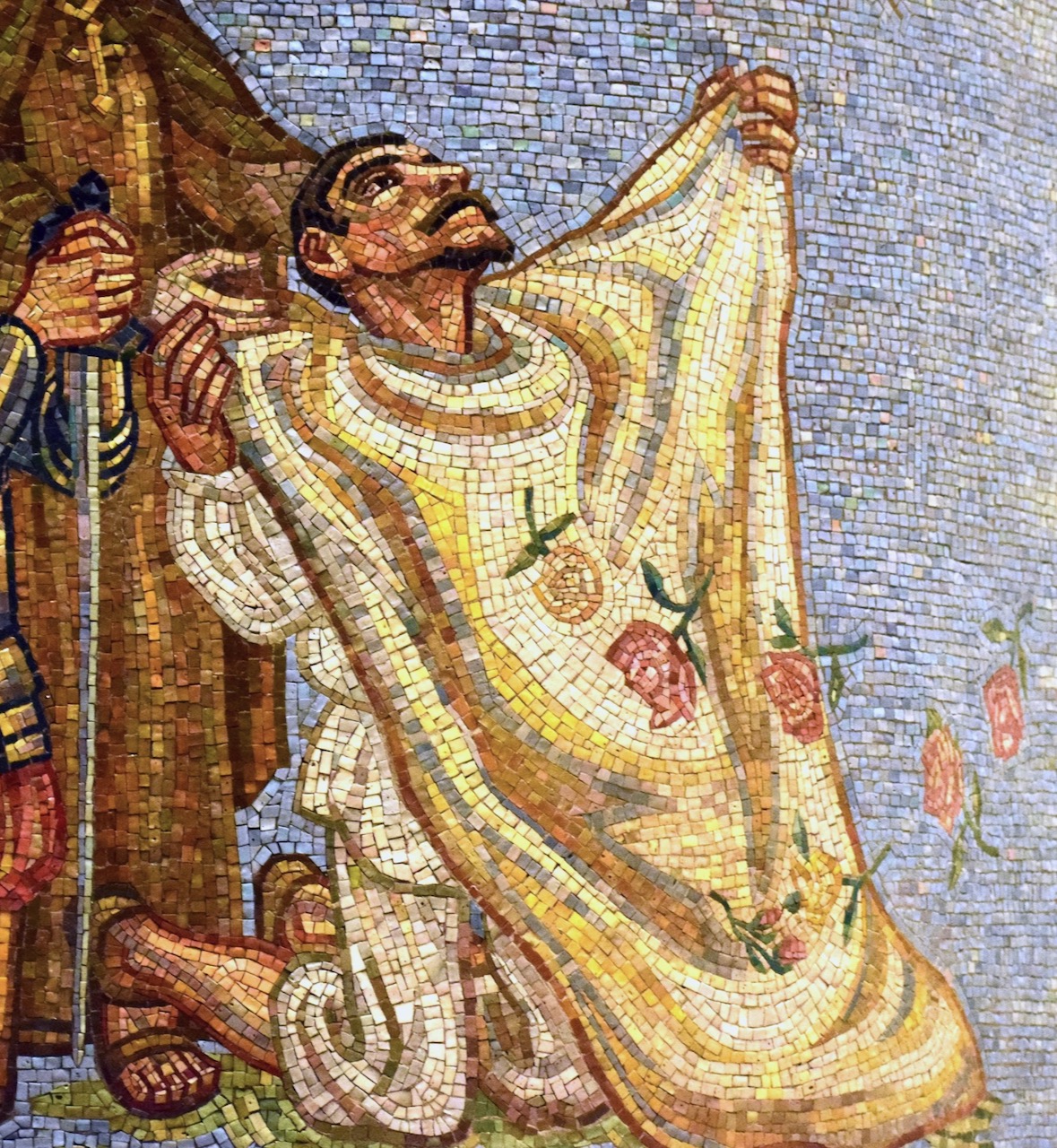 Born in 1474 near present-day Mexico City, Juan Diego was baptized by Franciscan missionary Friar Peter da Gand at the age of 50. According to tradition, as Juan Diego was making his way to Mass, Mary appeared to him and asked that he go to the bishop and request a shrine be built on the side of Tepayac Hill, that she might bless those who called upon her. When the bishop demanded evidence of the apparition, Juan Diego was disheartened, but returned to the hill to search for proof. There he found some roses miraculously blooming, though it was almost winter. He eagerly gathered the flowers up in his cloak, and when he presented them to the bishop, they fell to ground, leaving an image of the Blessed Mother imprinted on the garment where they had rested.
Born in 1474 near present-day Mexico City, Juan Diego was baptized by Franciscan missionary Friar Peter da Gand at the age of 50. According to tradition, as Juan Diego was making his way to Mass, Mary appeared to him and asked that he go to the bishop and request a shrine be built on the side of Tepayac Hill, that she might bless those who called upon her. When the bishop demanded evidence of the apparition, Juan Diego was disheartened, but returned to the hill to search for proof. There he found some roses miraculously blooming, though it was almost winter. He eagerly gathered the flowers up in his cloak, and when he presented them to the bishop, they fell to ground, leaving an image of the Blessed Mother imprinted on the garment where they had rested.
After the bishop witnessed the miraculous image, he gave his wholehearted support to the construction of a chapel. Juan Diego’s cloak was placed in the chapel upon its completion, as a reminder of the apparition. Juan Diego resided near the chapel for the rest of his life, acting as caretaker, welcoming pilgrims, and spending time in prayer and devotion.
St. Isaac Jogues
Born in 1607 and ordained as a Jesuit priest in 1636, St. Isaac Jogues was one of the earliest missionaries to the indigenous people in New France (now Eastern Canada and the Midwest United States) and was one of the first North American martyrs recognized by the Church. After a few years of ministry that were relatively uneventful, Isaac and his companions were captured by Iroquois in 1641. They whipped and tormented Isaac and his fellow missionaries for a full year, during which Isaac watched the brutal death of his companions. But torture and death were not enough to stop Isaac from evangelizing to the Iroquois during his captivity, and he even baptized several of them before escaping on a Dutch ship.
Despite his harrowing time as a captive, Isaac could not stop thinking about the Iroquois’s need for the Gospel. Only three months after his escape, knowing that to return likely meant death, he went back. He and his fellow missionary, Jean de Lalande, were killed en route to the Iroquois by a group of Mohawks in 1646. Before his return, Isaac said: “My heart tells me that, if I am the one to be sent on this mission, I shall go but I shall not return. But I would be happy if our Lord wished to complete the sacrifice where He began it.”
St. Kateri Tekakwitha
Kateri Tekakwitha was the first indigenous American to be canonized as a saint. Known as the “Lily of the Mohawks,” she is the patroness of ecology and the environment. Born to a Mohawk chief in 1656, Kateri was orphaned at age four after an epidemic of smallpox took both her parents and her brother. She was raised by her uncle in a Mohawk tribe community, and in 1676, Kateri was baptized by Father Jacques de Lamberville, a Jesuit missionary. Kateri became a devoted Christian, and at age 19, she took a vow of chastity. While her exemplary piety served as an inspiration to some of those around her, others harassed her because of her faith.
Seeking a less hostile environment, she moved to the settlement of the Mission of St. Frances Xavier, a community of Christian indigenous Americans living near what is now Montreal. There, she grew in faith and holiness, spurred on by an unquenchable zeal for Christ, living in prayer and penitence. Only five years later, however, she was called home by the Lord, passing away at the young age of 24 on April 17, 1680. Her last words were: “Jesus, I love you.”
St. Frances Xavier Cabrini
Often referred to as the mother of women’s missions, St. Frances Xavier Cabrini felt called to be a missionary from an early age. As a young girl in Italy, she would dress her dolls as nuns and send them down the river in boats as “missionaries.” She never lost her heart for missions, and at 27, approached a local bishop about the matter. At his suggestion, she founded the first institute for female missionaries: the Missionary Sisters of the Sacred Heart. Within a decade, it was recognized by Rome. When she was 30, she immigrated to New York City with six of her Sisters, intending to found orphanages in Little Italy. The plan was initially met with resistance from New York’s archbishop – primarily due to lack of funds. Regardless, Frances managed to secure $5,000 for the endeavor and was soon caring for over 400 orphans from the city streets. Later, she acquired 150 acres of land and established an orphanage in the countryside.
In her lifetime, Frances traversed the ocean 39 times, founding over 60 missions across Europe and the Americas. In 1946, she became the first American citizen to be canonized. She is the patroness of immigrants.
St. Elizabeth Ann Seton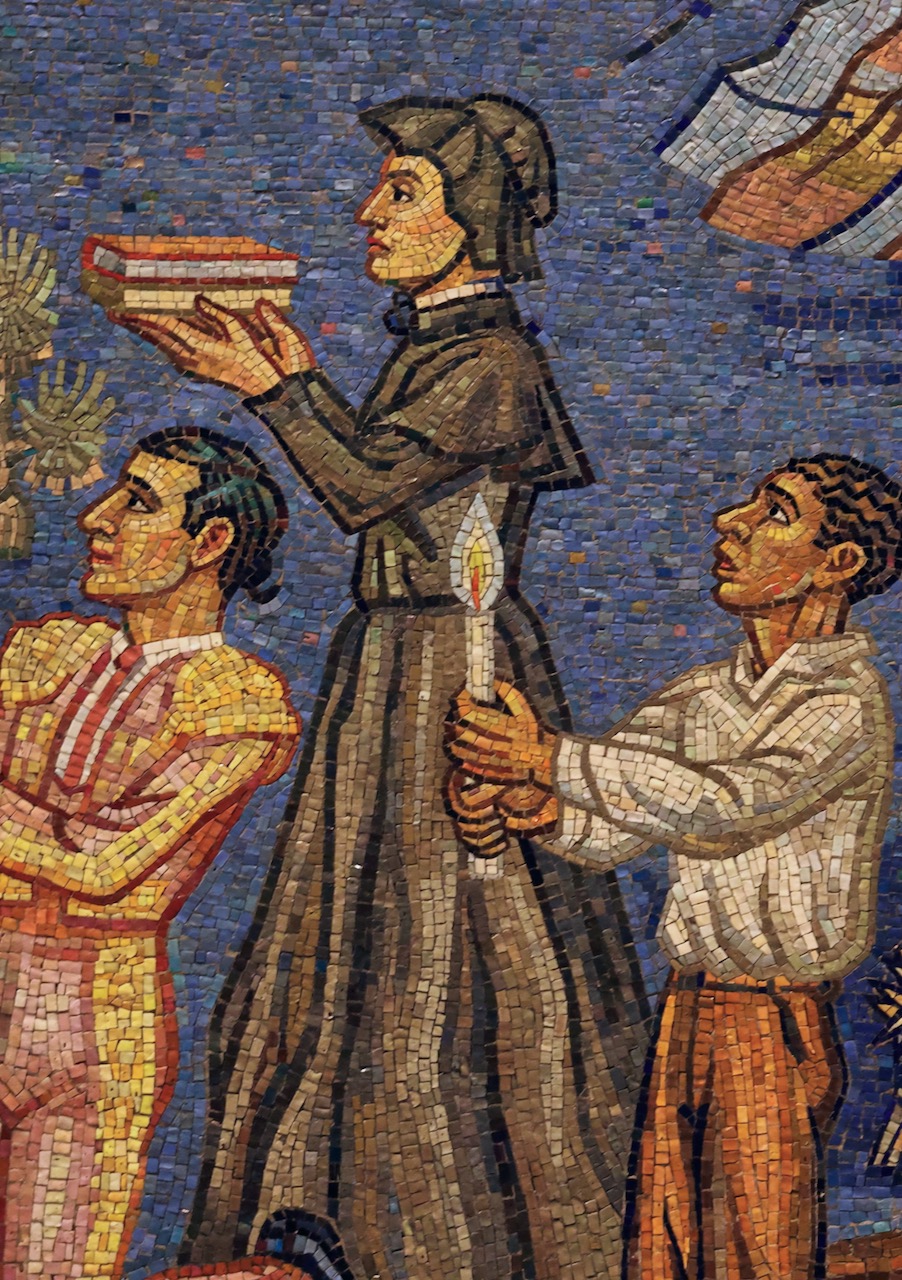
The first native-born American citizen to be canonized as a saint, Elizabeth Ann Seton is best known for her role in starting the parochial education system in America. Born on August 28, 1774, on Staten Island, Elizabeth was originally raised in the tradition of the Episcopal church. After spending time in Italy, she was struck by the beauty of Catholicism and converted in 1805. Following her husband’s premature death, Elizabeth started a Catholic school for girls in Baltimore, Maryland, at the request of a priest. Elizabeth’s most lasting impact, however, was the founding of the Sisters of Charity of Saint Joseph’s in 1809 – the first religious order in America. This order helped hospitals and orphans, but its most prominent work was in establishing the parochial education system in America. Elizabeth’s devotion to educating children and caring for the less fortunate has had an impact lasting well beyond her own life.
Sources:
A Biographical Profile of Kateri Tekakwitha, The Vatican.
Butler’s Lives of Saints, ed. Bernard Bangley.
“Juan Diego Cuauhtlatoatzin,” The Vatican.
Pope Francis’s Address to the Missionary Sisters of the Sacred Heart of Jesus, The Vatican.
Rohling, Geraldine M., PhD, MAEd. The Basilica of the National Shrine of the Immaculate Conception: Guide and Tour Book. Washington, D.C.: Basilica of the National Shrine of the Immaculate Conception, 2018.
“Saints Isaac Jogues, Jean de Brébeuf, and Companions,” Franciscan Media.
The Way of Saints, Tom Cowan.
Light a Candle at the Basilica
 In honor of Our Lady of Guadalupe, we invite you to light a candle today at the National Shrine. Vigil candles burn in the chapels throughout the Great Upper Church and lower crypt level of the National Shrine. Each candle represents the faith of the supplicants and their fervent prayers entrusted to the loving intercession of the Blessed Mother.
In honor of Our Lady of Guadalupe, we invite you to light a candle today at the National Shrine. Vigil candles burn in the chapels throughout the Great Upper Church and lower crypt level of the National Shrine. Each candle represents the faith of the supplicants and their fervent prayers entrusted to the loving intercession of the Blessed Mother.

